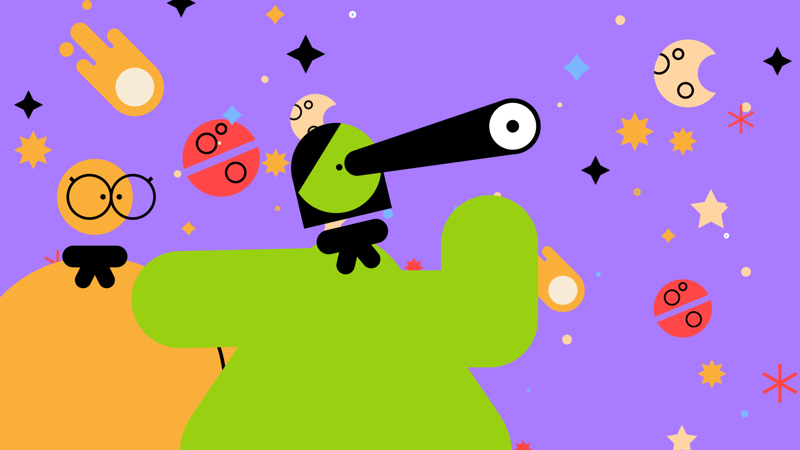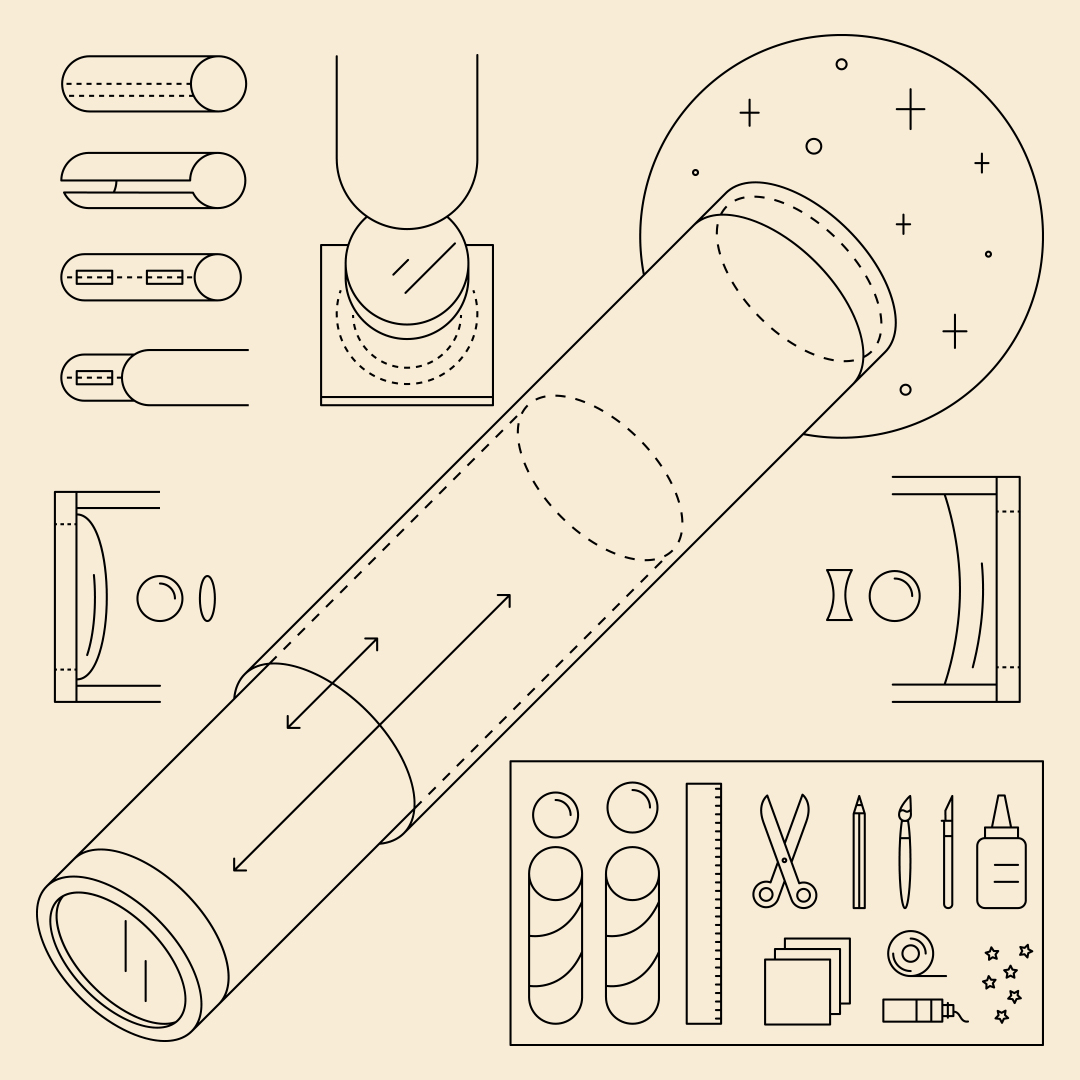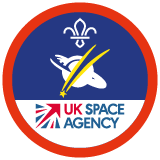
Telescopic creations
You’ll need
- Tables
- Chairs
- Pens or pencils
- Rulers
- Something to protect surfaces (for example, newspaper or tablecloths)
- Craft materials (for example, tissue paper, pipe cleaners, stickers)
- Scissors
- PVA glue
- Cardboard tubes
- Paint brushes
- 1cm wide concave lenses
- 1.5cm wide convex lenses
- Craft knives
- Sheets of cardboard
- Black electrical tape
- Black paint

Before you begin
- Use the safety checklist to help you plan and risk assess your activity. Additional help to carry out your risk assessment, including examples can be found here. Don’t forget to make sure all young people and adults involved in the activity know how to take part safely.
- Make sure you’ll have enough adult helpers. You may need some parents and carers to help if you’re short on helpers.
- If you’re going to use paint to decorate your telescopes, make sure people know to come to the meeting in clothes they don’t mind getting paint on.
- You can buy lenses online – they’re fairly cheap. It’s even better if you can repurpose lenses from old reading glasses or magnifying glasses.
- Set up tables with newspaper (or tablecloths) to protect them.
- Set out chairs and put a pile of materials in each place. Everyone will need two kitchen roll rubes and one of each lens.
Get into position
- Everyone should find their own seat.
- Explain that the night sky is full of different things, from stars and planets to satellites. There’s a limit to what the naked eye can see (and elements such as lights from a town or city can also limit what the eye can see). People use telescopes to be able to see more.
Make a telescope
- Draw two parallel lines from the top of one of the tubes to the bottom. The lines should be one centimetre apart.
- Use scissors to cut along the lines and remove a strip of the tube.
- Put the tube with the strip missing into the other tube. Squeeze the tube with the strip missing together slightly to make it fit, then check that it moves up and down the inside of the tube without catching on anything.
- Once the inner tube’s a perfect fit, tape it back together with black tape then try the sliding action again.
- Place the smaller, taped tube on a sheet of card and draw around the end with a pen or pencil.
- Use a ruler to draw a cross in the circle.
- Put the one centimetre concave lens in the centre of the circle and draw around it.
- Cut the larger circle out then use a craft knife to carefully cut out the smaller circle from the centre.
- Brush some glue around the edges of the small hole in the circle.
- Find the flat side of the one centimetre concave lens. Push the lens into the hole so that it sticks there with the flat side facing up. Wipe away any excess glue.
- Brush some glue around the edges of one end of the smaller, taped tube.
- Push the circle of card with the concave lens into the tube so that it sticks with the flat side facing up. Leave it to dry with the lens facing down so the lens can’t drop out and break.
- Once the glue’s dried, carefully tape over any joins with the black tape to keep any light out.
- Brush some glue around the edges of one end of the other tube. Take the one and a half inch lens and gently push it into the tube so that it sticks. Wipe away any excess glue. Again, leave this to dry with the lens facing down so the lens can’t drop out and break.
- Once the glue’s dried, decorate the telescope. You could use paint, pens, stickers, or other craft materials.
Discover the stars
- Everyone should take the telescopes outside and find a space.
- People should look through their telescopes and see which stars they can find.
- You could challenge everyone to find specific things like constellations, satellites or the North Star. However, make sure you can see anything you’re challenging people to find.
Reflection
The sky we see at night is full of different things, from stars and planets to satellites and asteroid showers.
To be able to see more, people and astronomers use telescopes of all different sizes. How did your team work together to make a telescope to help you look at the stars?
You needed a delicate touch to glue in the lenses and shape the inner tube and a creative approach to come up with a design.
The naked eye has a limit to what it can see. But also, depending on where you live, other elements can reduce what you’re able to see, such as urban lights.
How does your telescope help you see more? What could you change about your telescope to see even further? Think about other lenses and materials you could use.
Safety
All activities must be safely managed. You must complete a thorough risk assessment and take appropriate steps to reduce risk. Use the safety checklist to help you plan and risk assess your activity. Always get approval for the activity, and have suitable supervision and an InTouch process.
- Scissors
Supervise young people appropriately when they’re using scissors. Store all sharp objects securely, out of the reach of young people.
- Rubbish and recycling
All items should be clean and suitable for this activity.
- Glue and solvents
Always supervise young people appropriately when they’re using glue and solvent products. Make sure there’s plenty of ventilation. Be aware of any medical conditions that could be affected by glue or solvent use and make adjustments as needed.
- Sharp objects
Teach young people how to use sharp objects safely. Supervise them appropriately throughout. Store all sharp objects securely, out of the reach of young people.
- Dark
Provide some light, so the environment isn’t completely dark. Everyone must be able to see others and move around the area safely.
It’s up to you whether you challenge people to find things that are visible from where you are or whether people just enjoy seeing what they can find.
If it’s too cloudy, use the telescopes to pick out other distant objects or information.
If anyone doesn’t like the texture of the PVA glue, they could wear gloves. Someone else could help with this step, too.
If anyone doesn’t like the dark, you could give them a torch when you go outside. Chat to them about other things that would make it more manageable, such as staying near the door or being able to go back inside if they wanted to.
All Scout activities should be inclusive and accessible.
Once people have made their own telescopes, they could teach a younger group and help them to create their own telescope to see the stars. This could even work as an online activity.
This activity and badge can count towards a CREST Award.
Young people could source the materials themselves. They could also add their own creative touch to their telescope.
